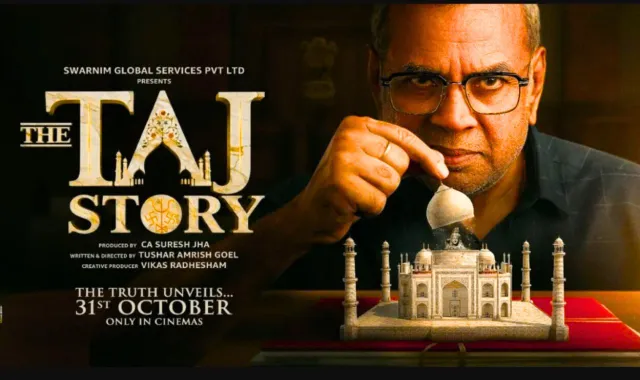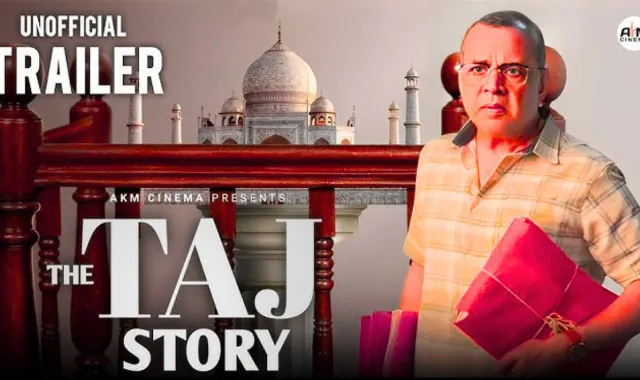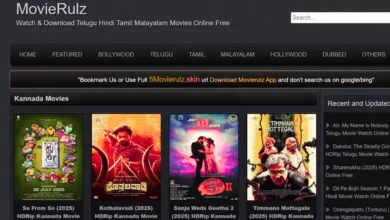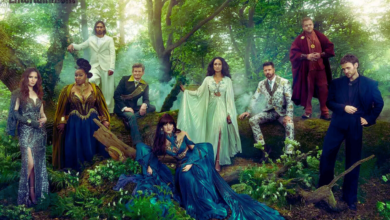The Taj Story Movie: Cast, Plot, Trailer & Release Date

When you think of the world’s most iconic monuments, the Taj Mahal often springs to mind—its gleaming white marble, the image of love immortalised in stone, the myth of a grieving emperor building a memorial for his beloved. But what if there is another story hidden beneath that sheen? What if the very foundation of the monument—and the narratives we accept—could be challenged?
Enter the film The Taj Story. A bold, provocative courtroom drama that doesn’t limit itself to retelling the legend of the Taj Mahal, but rather asks: What if the history we know is only half the tale? Starring veteran actor Paresh Rawal in a lead role that defies stereotypes, and directed by Tushar Amrish Goel, this movie sets out to weave an emotional, intellectual, and controversial narrative.
The cast, plot, trailer, release date, and the many layers of meaning behind The Taj Story—crafted for the curious, the cinema-lover, and the history enthusiast alike.
Quick Facts Table – The Taj Story At A Glance
The Vision Behind The Taj Story Movie

In an era where historical narratives are being revisited, contested, and sometimes weaponised, The Taj Story enters the arena with a clear purpose. Director Tushar Amrish Goel has openly stated that he aims to weave a dramatic story anchored in questions, not definitive declarations.
The film’s creators have framed it as more than a historical drama—it’s a “dialogue”, a challenge to the comfortable story, a mirror held up to heritage, national identity, faith, and fact. With Paresh Rawal’s character—a tour guide turned litigant—they show how even an ostensibly benign role can become the catalyst for seismic questions.
The production team chose real locations (such as parts around the Taj Mahal complex) to lend authenticity. They aimed to ground the film in tangible spaces rather than studio sets, because the monument at the heart of the story demands weight and presence.
Yet, the vision is twofold: one is emotional, the other intellectual. On the emotional side, the film plays on the familiar resonance of the Taj Mahal as love-made-stone. On the intellectual side, it invites us to ask: Who told this version of history? Why do we accept it? Could there be hidden rooms, hidden documents, hidden truths?
In many ways, The Taj Story bridges a genre gap: it’s not purely a history film or an action thriller—it’s a court drama steeped in history and social questionings, aimed at making viewers think and feel.
Plot Summary – A Tale of Truth, Belief, and Legacy
The story begins in the bustling lanes of Agra, under the shadow of the Taj Mahal. Here we meet Vishnu Das (Paresh Rawal)—a soft-spoken, decent tour guide whose life is entwined with the monument. Visitors flock, cameras click, and he narrates the conventional story: Emperor Shah Jahan, grief-stricken, builds a mausoleum for his beloved Mumtaz Mahal. People leave, move, but he keeps visiting day and night.
But one day, something stirs: a whisper among scholars, a hidden phrase in an old ledger, a mention of “22 locked rooms” beneath the monument, a DNA test suggestion—not in history books, but in hearsay. Vishnu begins to ask questions. He’s cautious at first: why does the tour script never mention these rooms? Why does the local guide code stay silent when “temple” is mentioned? Why is a certain chamber always closed to tourists?
His curiosity becomes an obsession when he files a lawsuit—yes, a licensed case in court—asserting that there are unanswered questions about the Taj Mahal’s origins. The film shifts from guided tours to court benches. Opposing him are historians, archaeologists, government lawyers, and vested interests. The courtroom scenes, intense and choreographed, ask us to listen: what is evidence? What is tradition? What is faith?
In one dramatic sequence, Vishnu raises the possibility of a DNA test being done on materials inside the Taj—an idea that sends shockwaves among the legal and academic community. The film doesn’t stop at conjecture; it shows alliances, betrayals, media noise, and the weight of expectations.
Amrita Khanvilkar’s character (a researcher) acts as Vishnu’s emotional compass—torn between professional duty and human imperative. Sneha Wagh and Namit Das play supporting roles that bring in personal stakes: family, past mistakes, and a tour guide’s simple life thrown into turmoil.
As the climax builds, the film returns to the monument itself. At dusk, under changing light, the Taj Mahal stands resilient. The courtroom verdict is not the end. Rather, the film ends on a question: “Can a monument survive the weight of truth, of belief, of identity?” The final frames leave you looking at its marble dome—not for what you know, but what you might now wonder.
Cast & Character Guide
Paresh Rawal as Vishnu Das: A seasoned actor known for his versatility, Rawal steps into the role of a tour guide with quiet conviction. Vishnu is ordinary, until he isn’t. Rawal’s performance is intentionally restrained—his voice measured, his gaze curious, his transformation subtle yet profound. His journey—from taking groups through the Taj to challenging its very history—anchors the film’s emotional and narrative core.
Amruta Khanvilkar: She plays a researcher—a bridge between academic coldness and human yearning. Through her, the film explores how monuments are not just stone and stories, but living parts of identity. Khanvilkar’s eyes often reflect that tension—knowledge vs faith, history vs heritage.
Zakir Hussain, Brijendra Kala & Namit Das: These actors bring depth as antagonists, courtroom supporters, and voices of tradition. Hassled historians, bureaucrats with agendas, tourists who only want pictures: they populate the world Vishnu enters. Their characters aren’t evil—they’re complex.
Sneha Wagh: A newer face in Bollywood, Wagh’s role shines as the personal cost of curiosity. She reminds the audience that when you challenge public narratives, private lives get caught in the crossfire.
Together, the cast creates a balanced ensemble: emotional, intellectual, and dramatic. The premiumness lies not just in star names, but in the fact that the story treats these characters with respect—they are not caricatures, even when their beliefs are questioned.
Behind the Scenes – Direction & Production Insights
Making The Taj Story was, by all accounts, no small feat. The crew chose on-location shooting in and around Agra, including parts of the Taj Mahal’s precincts, Mehtab Bagh, and nearby heritage zones. Working around tourism, conservation laws, and heritage restrictions posed logistic challenges—but also lent the film an authenticity often missing in heritage dramas.
Director Tushar Amrish Goel adopted a minimalistic style: long takes, natural light, real spaces. He avoided the temptation to glamorise; instead, he asked actors to engage with the monument as if they were regular visitors before the camera rolled. The script, reportedly, used actual tour-guide scripts, old archives, and legal records.
Music and cinematography are equally deliberate. The marble of the Taj becomes a character—its changing hues at dawn and dusk depicted with care. The camera lingers on symmetrical arches, on minarets leaning slightly outward (a historic earthquake precaution), on shadows and reflections in the water. The sound design keeps crowds low, footsteps echoing, whispers in corridors—reminding you of the weight of space and history.
In several marketing interviews, the team emphasised the film isn’t about pointing fingers—but about raising questions. That statement is important because the film treads a delicate line: heritage pride, national mythology, minority identity, historical evidence—all these fields intersect. The production’s decision to include disclaimers early on speaks to that caution.
The Trailer – What It Reveals
On 16 October 2025, the official trailer of The Taj Story dropped. It immediately stirred reactions—for its tone, for its claims, for its boldness.
Key moments from the trailer:
- Paresh Rawal’s voice-over: “DNA test karwalo.” (Get a DNA test done.)
- A shot of 22 locked rooms within the Taj Mahal complex, all filmed in quick succession, hints that the monument might hide more than we know.
- The tour guide turned litigant, walking into a massive courtroom, papers in hand, facing lawyers, historians, and media.
- A sequence where he stands before the dome of the Taj, raising his hand as if uncovering something beneath it.
- Overlaid text: “What if everything you’ve been taught is a lie?” – invoking intrigue (and debate).
Viewer reactions were mixed. Some praised the trailer for raising genuine historical questions. Others accused it of sensationalising heritage or of provoking controversy.
One YouTube comment reads: “Histology is not propaganda. Those Arab rulers really destroyed so many Hindu temples.” Critics wrote that the “DNA test” dialogue veered into fringe theories. Yet others defended the film’s right to ask questions—after all, history is never static.
When you watch the trailer, you sense tension, not spectacle. The streets of Agra, the whisper of arches, the courtroom’s fluorescent lights—all feel realistic. The music builds slowly before a crescendo of protest and revelation. It sets the tone for a film that is likely to be as much about ideas as it is about emotion.
Themes & Symbolism

The strength of The Taj Story lies not just in its plot, but in its themes—and in how the monument itself becomes a symbol rather than a setting.
Truth vs Tradition
One of the film’s central tension points: when do we accept a story because it’s comfortable, rather than because it’s been proven? Vishnu Das’s journey challenges the accepted narrative of the Taj Mahal and asks us: Are we open to dislodging a comfortable myth?
Faith vs Fact
In the courtroom setting, belief systems clash with archived documents, tour-guide scripts, witness testimony, and legal precedent. The film doesn’t caricature either side. Instead, it suggests that faith and fact both have power, and conflict arises when one dominates without question.
Love, Legacy & Identity
Of course, the Taj Mahal is often seen as a monument of love. The Taj Story uses that recognition as a launchpad, but then says: What does it mean when legacy is questioned? When does a symbol of love become a site of legal inquiry? The film invites us to reflect on how heritage shapes identity—and how identity changes when heritage is contested.
Monuments as Voices
The cinematography emphasises the Taj Mahal not simply as a backdrop, but as a witness — its silent rooms, locked chambers, shadows, and reflection pools. The 22 locked rooms mentioned in the film serve as a metaphor: hidden histories, unseen truths, silent voices.
The Individual vs The Collective
Vishnu Das stands alone at first: a tour guide, unremarkable. Yet his voice shakes the courtroom, the media, and the public. The film suggests that even one individual’s curiosity can ripple outward: perhaps to history, perhaps to identity.
These themes make The Taj Story richer than a simple “historical thriller.” It becomes a film about how we tell stories, why we tell them, and what happens when we question them.
Music & Cinematography
While the film has not yet released its full soundtrack publicly, promotional materials indicate a soundtrack by Rohit Sharma and Rahul Dev Nath.
Expect a score that juxtaposes classical Indian instrumentation—evoking the Taj’s Mughal heritage—with modern orchestral tension—evoking the courtroom stakes. The cinematography by Satyajit Hajarnis uses the monument’s architecture to dramatic effect: long tracking shots down the reflecting pool, macro details on carved marble, drone shots that take you above the dome and minarets.
Colour palettes shift: morning soft gold, midday bright white, dusk amber—and then cold fluorescent courtrooms. This contrast reinforces the film’s dual nature: heritage and contemporary reckoning. The visuals are not flashy—they invite contemplation.
Public Response & Controversy
No film that challenges history and heritage escapes controversy—and The Taj Story has been the subject of heated debate even before its release.
Poster Backlash
In late September 2025, a motion poster of the film showed Paresh Rawal’s character lifting the dome of the Taj Mahal, with a Shiva idol emerging from within. This image ignited social media uproar—some viewing it as provocative, others as thought provoking.
The filmmakers quickly issued a statement clarifying: “The movie does not deal with any religious matters, nor does it claim a Shiv temple resides within the Taj Mahal. It focuses solely on historical facts.”
Allegations of Propaganda
Critics accused the film of promoting the “Tejo Mahalaya theory” (a claim that the Taj Mahal stands on the site of a pre-existing Hindu temple)—a theory widely dismissed by historians.
One article pointed out: “The film’s narrative … draws inspiration from claims popularised by writer P. N. Oak … These claims have been widely debunked by mainstream historians and archaeologists as pseudo-history.”
Support & Curiosity
At the same time, many viewers expressed curiosity and support. The idea of viewing the iconic Taj Mahal through a new lens appealed to some—not necessarily because they agreed with every claim, but because the film dared to ask questions.
One YouTube comment after the trailer: “The trailer raises valid questions… maybe we have been telling the same story for too long.”
CBFC & Certification
Because of its subject matter, the film was reportedly subject to rigorous scrutiny by the Central Board of Film Certification (CBFC), which asked the makers to submit historical documentation validating the claims made in the film.
In sum, the public response has been polarised: part debate-forum, part film-marketing. The controversy itself amplifies the visibility of the film, but the team appears intent on making the film about more than provocation.
Release Date & Distribution Plans
The Taj Story is scheduled for a theatrical release on Friday, 31 October 2025. The date holds significance—it coincides with the birth anniversary of Sardar Vallabhbhai Patel, a figure often associated with national unity and identity.
Early listings (for example, on BookMyShow) show that the film is expected to receive wider release across India—especially in Hindi-speaking states and overseas Indian diaspora markets.
While the OTT release window has not been officially announced, industry sources suggest a post-theatrical window of about 8–10 weeks before streaming platforms pick it up. The filmmakers are also reportedly eyeing English subtitles and select international screenings, given the universal recognition of the Taj Mahal.
For viewers planning to watch: booking early may help, especially in tier-2/tier-3 cities where repertoire screens may be limited. Given the film’s somewhat controversial nature, expect lively post-screening discussions.
Why You Should Watch The Taj Story Movie
If you’re undecided about whether this film is for you, here are several reasons that might push you into the theatre:
- Strong Lead Performance – Paresh Rawal brings emotional restraint and credibility to the role of Vishnu Das. He doesn’t over-act; he makes you care.
- Rare Genre Fusion – Court-room drama plus heritage mystery plus social commentary. That’s not common in mainstream Hindi cinema.
- Thought-Provoking Narrative – The film doesn’t hand you answers. It gives you questions—and sometimes that’s more valuable.
- Visual & Emotional Weight – The Taj Mahal isn’t just referenced; it’s filmed, felt, and interrogated. Expect quiet moments of reflection.
- Conversation Starter – Whether you agree with its premise or not, the film will provoke talk about history, memory, monuments, and identity.
- Accessible for Non-Experts – You don’t need a degree in history. The story is grounded in a tour guide’s viewpoint, making the journey relatable.
This movie reminds us that monuments are not just tourist spots—they carry memories, meanings, and sometimes, mysteries.
Comparison with Similar Films
While The Taj Story is unique, there are other Indian films you might have seen that share some DNA. Let’s briefly compare:
- Jodha Akbar – A grand historical romance with opulence, war, and dynasty. The Taj Story is smaller in scale, leaner in style.
- Tanhaji – A battle-epic, rich in spectacle. The Taj Story uses spectacle sparingly, opting for subtlety and tension.
- Oh My God 2 – A film that challenges religious belief through satire and courtroom drama. The Taj Story also uses courtroom elements—but is rooted more in heritage and identity than in religious critique.
What sets The Taj Story apart is its willingness to interrogate a monument’s story from within the story itself. The monument becomes a character—and the tour guide becomes a catalyst.
The Message Behind the Movie

At its heart, The Taj Story isn’t just about “what happened” but “what could have happened” and “why we believe what we believe.” The film asks viewers to consider:
- How do we know what we know?
- When heritage becomes unquestioned, does it become frozen?
- Can monuments hold more than memory—they might hold mysteries.
- And perhaps most importantly: that questions don’t diminish reverence—they deepen it.
In an age of fast streaming and loud spectacle, this film invites patience and reflection. It invites you to stop, look, think, and feel. It’s a movie that acknowledges that monuments carry stories—but that stories also carry monuments.
FAQs
Q1. What is The Taj Story movie about?
Ans: It’s a courtroom drama following Vishnu Das, a tour guide at the Taj Mahal, who begins to question the accepted history of the monument and drags the case into legal battle.
Q2. Who plays the lead role in The Taj Story movie?
Ans: Veteran actor Paresh Rawal stars as Vishnu Das, supported by Amruta Khanvilkar, Zakir Hussain, Sneha Wagh, and Namit Das.
Q3. When is The Taj Story movie releasing?
Ans: The film is scheduled to release theatrically on 31 October 2025 in India.
Q4. Who directed The Taj Story?
Ans: It is written and directed by Tushar Amrish Goel, produced by CA Suresh Jha under Swarnim Global Services Pvt. Ltd.
Q5. Why is The Taj Story movie creating buzz online?
Ans: The film raises provocative questions about the Taj Mahal’s origins, uses courtroom drama to challenge accepted narratives, and stirred controversy with its poster and trailer—making it widely discussed ahead of release.
Q6. Is The Taj Story movie based on real events?
Ans: While inspired by ongoing debates and discussions regarding the Taj Mahal’s history, the film is a dramatized narrative. It does not claim to be a documentary or definitive historical proof.
Q7. Where can I watch The Taj Story movie?
Ans: Initially releasing theatrically on 31 October 2025. OTT platform details will likely follow after the theatrical window—keep an eye on official announcements.




